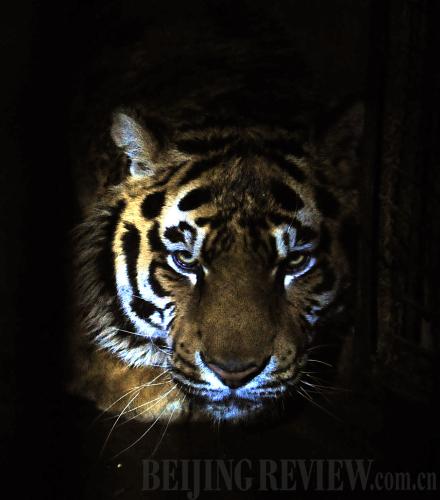|
 |
|
LUCKY SURVIVOR: The photo shows a Siberian tiger at the Shenyang Forestry Wild Animals Zoo on March 13, which was spared from death by starvation (YAO JIANFENG) |
Though this year is the year of Tiger according to Chinese lunar calendar, local animal protection officials in northeast China's Liaoning Province have revealed that a total of 11 Siberian tigers have died in the Shenyang Forestry Wild Animals Zoo (SFWAZ) since November 2009.
The 11 tigers died of heart, kidney and lung failure, hemorrhagic enteritis and myocarditis, according to a report provided by the zoo to the Shenyang Wild Animal Protection Station.
These ailments were the result of malnutrition rather than infectious diseases, said Liu Xiaoqiang, deputy director of the protection station.
Liu Mingyu, a professor with the School of Life Sciences at Liaoning University, explained that heart and kidney are the first organs to fail as a result of malnutrition.
The road to death
The scandal at the zoo was exposed by disgruntled staff on March 10 when they went on strike over unpaid wages. According to the staff, this was not the first time that the zoo has been mired in scandal.
On November 13 last year, two Siberian tigers, allegedly also suffering from extreme malnutrition, were shot dead after they mauled Yang Jingwei, a 51-year-old zoo worker.
In November 2007, three Siberian tigers attacked and ate another tiger in their enclosure due to hunger.
In June 2004, a tiger attacked Xu Yajun, a feeder at the zoo. Xu eventually died from his injuries and the tiger was placed in isolation.
The SFWAZ was previously the Shenyang City Zoo, which was built in 1979, and situated in the east of the city's downtown area. In 1995, the zoo was honored as one of the best zoos in China.
However, during the wave of construction of wild animal zoos in the mid-1990s, the SFWAZ was shifted to the city's suburbs and converted into a wildlife zoo.
On June 4, 1999, the Department of Construction of Liaoning Province submitted a report to the then Ministry of Construction, applying for permission to build the zoo.
The Shenyang Municipal Government previously signed a management contract with a private company on July 20, 1998. According to the contract, the municipal government would only hold a 15-percent share in the business.
On December 9, 2000, the zoo was opened to the public. It lies in the Qipanshan Development Zone, 25 km away from the city's downtown area. According to the Shenyang-based Commercial Times, the annual revenue of the zoo in the first three years reached 20 million yuan ($2.93 million) and each tiger at the zoo received 7-8 kg of food per day, including chicken, beef, eggs and other food stuffs containing abundant amounts of Vitamin E.
However, the zoo started to suffer from difficulties in 2003 due to the Severe Acute Respiratory Syndrome (SARS) crisis.
In 2006, the annual revenue of the zoo fell to approximately 14 million yuan ($2.05 million) and in November of the same year, its owner closed the zoo, claiming that ticket revenue had failed to cover costs. He called on residents to donate money for the zoo's upkeep, and within several months had received 1.5 million yuan ($219,600) from the municipal government.
The zoo has received 2 million yuan ($293,000) in annual support from the municipal government since then.
Only four months later, however, the zoo again declared that the subsidy from the municipal government had been completely run out, and that there was no longer sufficient money to purchase food for its animals.
According to the Shenyang-based Liaoshen Daily, the tigers were fed nothing but the bones of one or two chickens a day for over two years. However, according to the World Association of Zoos and Aquariums, large feline species require 5 to 6 kg of meat with bones each day to be in normal health.
According to Liu Mingyu, after the two Siberian tigers at the zoo were shot dead because of their attack upon a zoo worker, all the tigers were kept in narrow cages with no open areas for exercise, causing further detriment to the famished animals' immune systems.
Since November last year, the Shenyang Qipanshan Administration Committee, which is the management body representing the Shenyang Municipal Government, has been providing the zoo with suitable types of feed worth 18,000 yuan ($2,635) a day. But many tigers had already suffered from intestinal infections or kidney failure due to lack of food, and subsequently died of their ailments.
Following the deaths by starvation of 11 tigers in the zoo, the State Forestry Administration sent a work team to conduct an investigation on March 13.
Full examinations of the 30 remaining tigers in the zoo on March 15 showed that three were in a critical condition and one of them was on the verge of death, according to Zhang Chenglin, Director of the Veterinary Hospital at Beijing Zoo and one of the three experts who investigated the tragedy.
In addition to the tigers, 22 other animals at the zoo were also reported dead in January, according to a list of animals in the SFWAZ which Xinhua News Agency obtained from the zoo on March 14.
Some of the dead animals, including a red-crowned crane, four stump-tailed macaques, a rhesus monkey and a brown bear, were state-protected species, according to the zoo's list. The zoo only registered the deaths of these animals in January.
The list also revealed that among the dead animals were four camels, one African lion, one yak, one ostrich, one springbok, one dalmatian, and a Mongolian horse.
The number of animals in the zoo has dropped by half in a decade, from 1,020 animals of different species in 2000, to 518 animals of 49 species as of February 8 this year.
| 